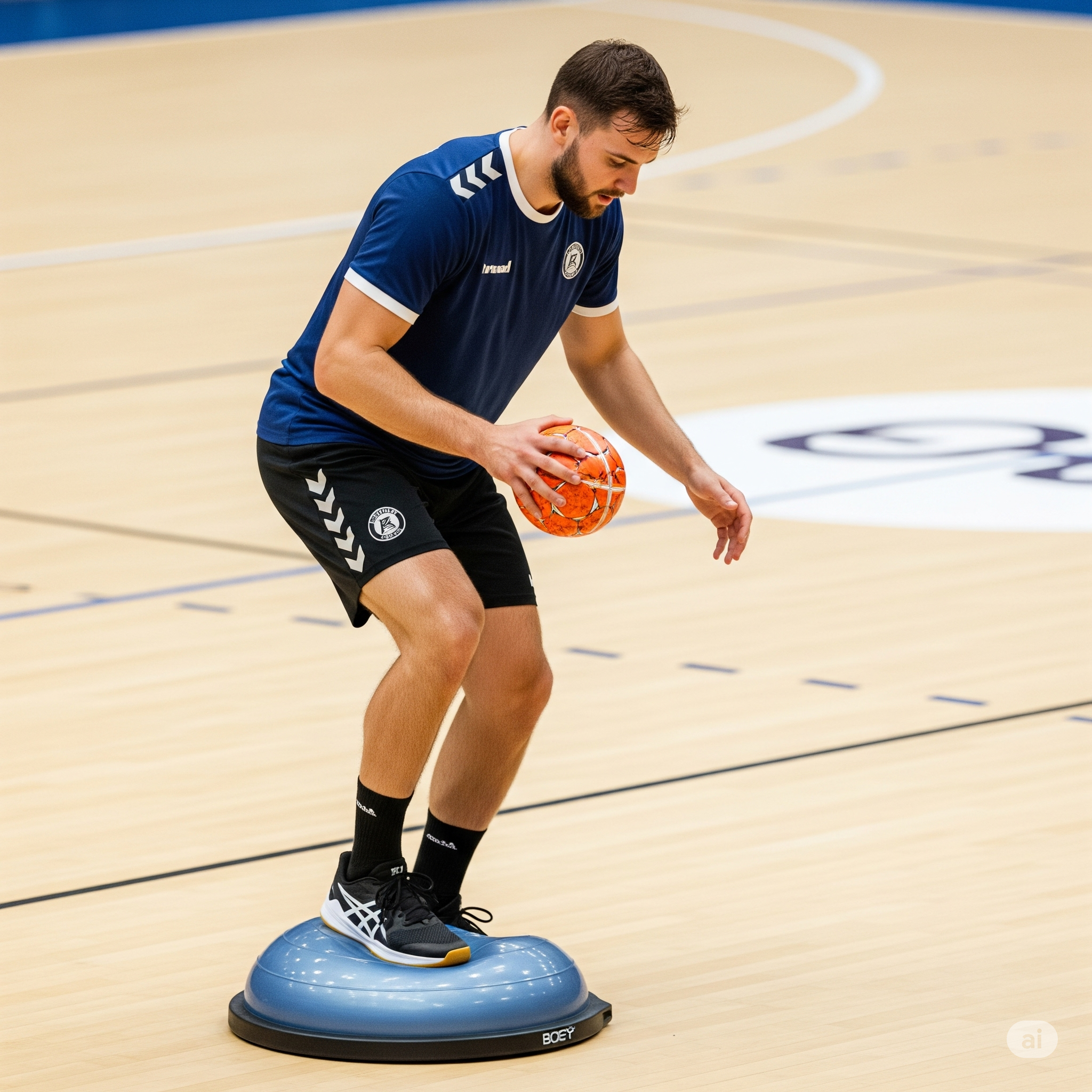In handball, controlling your body in the air is a crucial skill that impacts performance in various aspects, including jump shots, aerial passes, and blocks. One highly effective way to enhance this aerial control is through “training on unstable surfaces.” Here, we’ll explore its benefits, specific methods, and how you can practice even without special equipment.
Why Is Training on Unstable Surfaces So Effective?
When you train on an unstable surface, your body instinctively works to maintain balance. This activates the deep core muscles (abdominal, back, and pelvic muscles) and refines your sense of balance. These are areas that are difficult to target with conventional flat-ground training, yet they’re essential for reacting to the unpredictable movements required in airborne handball plays.
- Core Strengthening: By trying to stay balanced on a wobbly surface, your core muscles, which stabilize your body’s axis, are naturally strengthened.
- Improved Balance: Responding to tilts and wobbles sharpens your ability to instantly sense and correct your body’s center of gravity.
- Enhanced Proprioception: Your “proprioception” – the sense of your body’s position and movement without visual input – improves, leading to more accurate movements in the air.
- Injury Prevention: Better body control in unstable situations can reduce stress on your knees and ankles during landing, potentially lowering the risk of sprains and other injuries.
Training on Unstable Surfaces: With Equipment
Gyms and training facilities often have various tools designed to create unstable environments.
- Balance Discs/Balls: Stand on these with one foot, or perform squats and lunges. The unstable spherical or air-filled surfaces provide a strong stimulus for balance and core stability.
- BOSU® Ball: This device has one flat side and one dome-shaped side. Standing on the dome side or performing push-ups with the flat side up helps improve overall body stability.
- Slackline: Walking on a tensioned strap strung between two points. This requires an extremely high level of balance and concentration.
Training on Unstable Surfaces: No Equipment Needed!
Even without special equipment, you can create unstable environments using everyday items or by making small adjustments.
1. Single-Leg Standing Series
This is a fundamental yet highly effective training method.
- Basic Single-Leg Stand:
- Lift one foot and balance on the other. You can bend the lifted knee and bring it forward, or slightly extend it backward.
- Fix your gaze on a single point to prevent your body from swaying.
- Start with 10 seconds and gradually work up to 30 seconds to 1 minute.
- Closing your eyes will significantly increase the difficulty.
- Single-Leg Squat (Precursor to Pistol Squats):
- From a single-leg stance, slowly bend the knee of your supporting leg, lowering your hips as if performing a squat.
- Maintain balance as you lower yourself as deep as possible, then slowly return to the starting position. Focus on proper form, even if you can only go shallow initially.
- Single-Leg Deadlift:
- From a single-leg stance, extend your lifted leg backward as you lean your torso forward, aiming for a “T” shape with your body.
- Slowly return to the starting position while maintaining balance. Keeping your back straight is crucial.
2. Utilize Variations in the Ground
Look for slightly unstable surfaces in your everyday environment and make use of them.
- Cushions or Folded Towels: Place a cushion or a folded towel on the floor and perform single-leg stands or light squats on it. The soft surface creates instability.
- Grass or Sandy Beaches: Uneven ground naturally provides an unstable environment. Running on grass or performing jumps and single-leg stands on sand can also strengthen your foot muscles.
- Walking/Running on Embankments or Slopes: Walking or running on natural inclines or uneven terrain helps develop the ability to adapt to irregular shifts in your center of gravity.
3. Incorporate Movement
Adding movement, not just static poses, can train your balance in a way that’s closer to actual game situations.
- Single-Leg Arm Swings/Leg Lifts: While standing on one leg, incorporate arm swings or move your lifted leg in various directions. Try to mimic handball shooting or passing motions.
- Line Walk (Heel-to-Toe Walk): Practice walking along a straight line, placing the heel of one foot directly in front of the toes of the other. This builds concentration and balance.
Important Considerations for Training
- Safety First: Don’t overdo it, especially when starting. To avoid falls, ensure you have a safe environment, such as near a wall or railing.
- Maintain Proper Form: Don’t let your focus on balance compromise your form. Pay attention to proper technique, especially when performing squats or deadlifts.
- Consistency is Key: Training on unstable surfaces requires consistent effort. Even short sessions daily will lead to tangible improvements over time.
By incorporating these training methods into your routine, you can significantly enhance your stability, precision, and injury resilience in aerial handball plays. Give them a try!



コメント